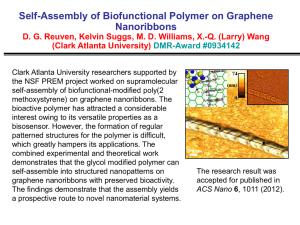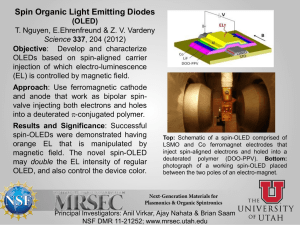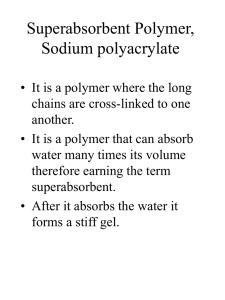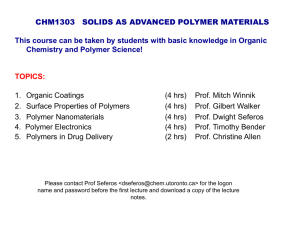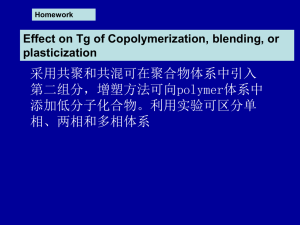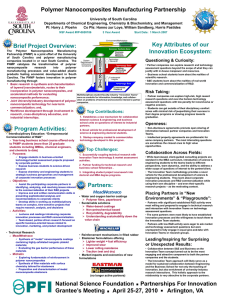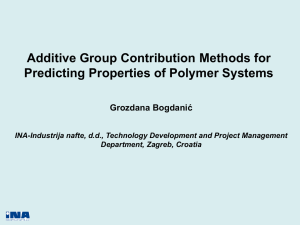polymer-solvent interactions
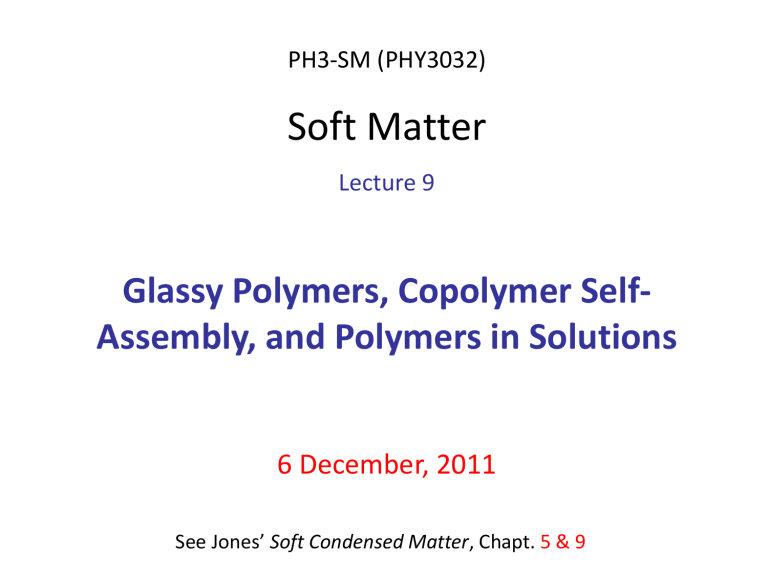
PH3-SM (PHY3032)
Soft Matter
Lecture 9
Glassy Polymers, Copolymer Self-
Assembly, and Polymers in Solutions
6 December, 2011
See Jones’ Soft Condensed Matter, Chapt. 5 & 9
Polymer Conformation in Glass
In a “freely-jointed” chain, each repeat unit can assume any orientation in space.
Shown to hold true for polymer glasses and melts.
Describe as a “random walk” with N repeat units (i.e. steps), each with a size of a : N
R
3
=
a
1
+
1
a
2
2
+
a
3
+ ...
a
a
N
=
i=1
a i
R
The average R for an ensemble of polymers is
0.
But what is the mean-squared end-to-end distance, ?
Random Walk Statistics
R •
R =
( a i
) •
( )
•
a j=1 j j
34 a
4
23 a
3
R
2 i=1
=
a i a
1
12 a
2
By definition:
a i
•
a j
Those terms in which i=j can
=
a i
a i a
j be simplified as:
R
2
= Na
2
+ 2 a
2 i
j
a
cos
ij j cos
ij a i
2 cos
ii
a 2
The angle
can assume any value between 0 and 2 p and is uncorrelated. Therefore:
Finally, R
2
= Na
2 cos
ij
= 0
Compare to random walk statistics for colloids!
Defining the Size of Polymer Molecules
We see that
R
2
= Na
2 and
R
2
1
2
= N
1
2 a
(Root-mean squared end-to-end distance)
Often, we want to consider the size of isolated polymer molecules.
In a simple approach, “freely-jointed molecules” can be described as spheres with a characteristic size of
R
2
1
2
Typically, “ a ” has a value of 0.6 nm or so. Hence, a very large molecule with 10 4 repeat units will have a r.m.s. end-to-end distance of 60 nm.
On the other hand, the contour length of the same molecule will be much greater: a N = 6x10 3 nm or 6 m m!
Scaling Relations of Polymer Size
R
2
1
2
~ N
1
2
Observe that the rms end-to-end distance is proportional to the square root of N (for a polymer glass).
Hence, if N becomes 9 times as big, the “size” of the molecule is only three times as big.
However, if the molecule was straightened out, then its length would instead be proportional to N.
Concept of Space Filling
Molecules are in a random coil in a polymer glass, but that does not mean that it contains a lot of “open space”.
Instead, there is extensive overlap between molecules.
Thus, instead of open space within a molecule, there are other molecules, which ensure “space filling”.
Distribution of End-to-End Distances
In an ensemble of polymers, the molecules each have a different end-to-end distance, R.
In the limit of large N, there is a Gaussian distribution of end-to-end distances, described by a probability function (number/volume):
P ( R )
[ 3 /( 2 p
Na
2
)]
3 / 2 exp(
3 R
2
)
2 Na
2
Larger coils are less probable, and the most likely place for a chain end is at the starting point of the random coil.
Just as when we described the structure of glasses, we can construct a radial distribution function, g(r), by multiplying P(R) by the surface area of a sphere with radius, R: g ( R )
4 p
R
2
[ 3 /( 2 p
/ Na
2
)]
3 / 2 exp(
3 R
2
)
2 Na
2
P ( R )
R
2
= N a g ( R )
From U. Gedde, Polymer Physics
Radius of Gyration of a Polymer Coil
The radius of gyration is the root-mean square distance of an objects' parts from its centre of gravity.
R
For a hard, solid sphere of radius, R, the radius of gyration , R g
, is:
R g
=
2
5
R =
10
5
R = 0 .
632 R
R
A polymer coil is less dense than a hard, solid sphere. Thus, its R rms-R: g is significantly less than the
R g
=
1
6
R
2
1 2
= a
6
N
1
2
Entropic Effects
Recall the Boltzmann equation for calculating the entropy, S, of a system by considering the number of microstates,
, for a given macro-state:
S = k ln
In the case of arranging a polymer’s repeat units in a coil shape, we see that
= P(R), so that:
S ( R ) =
3 kR
2
2 Na
2
+ const .
If a molecule is stretched, and its R increases, S(R) will decrease
(become more negative).
Intuitively, this makes sense, as an uncoiled molecule will have more order (i.e. be less disordered).
Concept of an “Entropic Spring”
Fewer configurations
R
R
Decreasing entropy
Helmholtz free energy: F = U - TS
Internal energy, U, does not change significantly with stretching.
F ( R ) =
3 kR
2
+
2 Na
2
T + const .
Restoring force, f f
dF dR
3 kTR
Na 2
Difference between a Spring and a Polymer Coil
U = (
1
2
) k s x
2 x f f
In experiments, f for single molecules can be measured using an AFM tip!
Spring
Polymer
Entropy (S) change is negligible, but
D
U is large, providing the restoring force, f .
S change is large; it provides the restoring force, f .
Molecules that are Not Freely-Jointed
In reality, most molecules are not “freely-jointed” (not really like a pearl necklace), but their conformation can still be described using random walk statistics .
Why?
(1) Covalent bonds have preferred bond angles.
(2) Bond rotation is often hindered.
In such cases, g monomer repeat units can be treated as a “statistical step length”, s (in place of the length, a ).
A polymer with N monomer repeat units, will have N/g statistical step units.
The mean-squared end-to-end distance then becomes:
R
2
=
N g s
2
Example of Copolymer Morphologies
Immiscible polymers can be “tied together” within the same diblock copolymer molecules. Phase separation cannot then occur on large length scales.
2 m m x 2 m m
Poly(styrene) and poly(methyl methacrylate) diblock copolymer
Poly(ethylene) diblock copolymers
Self-Assembly of Di-Block Copolymers
Diblock copolymers are very effective “building blocks” of materials at the nanometer length scale.
They can form “lamellae” in thin films, in which the spacing is a function of the sizes of the two blocks.
At equilibrium, the block with the lowest surface energy, segregates at the surface!
g ,
The system will become “frustrated” when one block prefers the air interface because of its lower g
, but the alternation of the blocks requires the other block to be at that interface. Ordering can then be disrupted.
d
Thin Film Lamellae: Competing Effects
The addition of each layer creates an interface with an energy, g
. Increasing the lamellar thickness reduces the free energy per unit volume and is therefore favoured by g
.
Increasing the lamellar thickness, on the other hand, imposes a free energy cost, because it perturbs the random coil conformation .
There is thermodynamic competition between polymer chain stretching and coiling to determine the lamellar thickness, d.
The value of d is determined by the minimisation of the free energy.
Poly(styrene) and poly(methyl methacrylate) copolymer
Interfacial Area/Volume
Area of each interface: A = e 2 e e
V = e
3 d=e/3 e
In general, d = e divided by an integer value.
Lamella thickness: d
Interfacial Area/Volume:
A
V
=
3 e
2 e
3
=
3 e
1
= d
Determination of Lamellar Spacing
•
Free energy increase caused by chain stretching (per molecule):
F str kT d
2 Ratio of (lamellar spacing) 2
(random coil size) 2
Na
2 to
•
The interfacial area per unit volume of polymer is 1/d, and hence the interfacial energy per unit volume is g
/ d .
• The volume of a molecule is approximated as Na 3 , and so there are 1/(Na 3 ) molecules per unit volume.
• Free energy increase (per polymer molecule) caused by the presence of interfaces: g
Na
3
F int d
Total free energy change: F total
= F str
+ F int
Free Energy Minimisation
F
F int
F str
F tot d
2
kT
Na
2
+ g
Na
3 d
Two different dependencies on d!
F tot
Finding the minimum, where slope is 0:
F tot d
0
2 kT d
Na 2 d d
2 kT
Na
2
= g
Na
3 d
2 d = g a
5
(
2 kT
)
1 / 3
N
2 / 3 d
3
= g
N
2 a
5
2 kT
Chains are NOT fully stretched - but nor are they randomly coiled!
g
Na 3 d 2
The thickness, d, of lamellae created by diblock copolymers is proportional to N 2/3 . Thus, the molecules are not fully-stretched (d ~
N 1 ) but nor are they randomly coiled (d ~ N 1/2 ).
Experimental Study of Polymer Lamellae
Small-angle X-ray Scattering (SAXS)
Transmission Electron Microscopy
Poly(styrene)bpoly(isoprene)
(°)
T. Hashimoto et al.,
Macromolecules (1980) 13, p.
1237.
Support of Scaling Argument
2/3
T. Hashimoto et al., Macromolecules (1980) 13, p.
1237.
Micellar Structure of Diblock Copolymers
When diblock copolymers are asymmetric, lamellar structures are not favoured – as too much interface would form!
Instead the shorter block segregates into small spherical phases known as “micelles”.
Interfacial “energy
cost”: g
(4 p r 2 )
Density within phases is maintained close to the bulk value.
Reduced stretching energy when the shorter block is in the micelle.
AFM image
Copolymer Micelles
5 m m x 5 m m
Diblock copolymer of poly(styrene) and poly(vinyl pyrrolidone): poly(PS-b-PVP)
Diblock Copolymer Morphologies
Gyroid
TRI-block
Lamellar Cylindrical Spherical micelle
Pierced Lamellar Gyroid Diamond
“Bow-Tie”
Copolymer Phase Diagram
N
~ 10 f
From I.W. Hamley, Intro. to Soft
Matter, p. 120.
Applications of Self-Assembly
Creation of “photonic band gap” materials
Images from website of Prof. Ned Thomas, MIT
In photovoltaics for solar cells, excitons decay into electrons and holes.
Controlled phase separation of p-type/n-type diblock copolymers could allow a large contact area between the two phase.
http://crg.postech.ac.kr/korean/viewforum.php?f=90
Nanolithography
Thin layer of poly(methyl methacrylate)/ poly(styrene) diblock copolymer. Image from
IBM (taken from BBC website)
Nanolithography to make electronic structures, such as “flash memories”
From Scientific American,
March 2004, p. 44
The Self-Avoiding Walk
In describing the polymer coil as a random walk, it was tacitly assumed that the chain could “cross itself”.
The conformation of polymer molecules in a polymer glass and in a melted polymer can be adequately described by random walk statistics.
But, when polymers are dissolved in solvents (e.g. water or acetone), they are often expanded to sizes greater than a random coil.
Such expanded conformations are described by a “selfavoiding walk” in which <R 2 > 1/2 is given by a N n
(instead of aN 1/2 as for a coil described by a random walk).
What is the value of n
?
Excluded Volume
Paul Flory developed an argument in which a polymer in a solvent is described as N repeat units confined to a volume of
R 3 .
Each repeat unit prevents other units from occupying the same volume. The entropy associated with the chain conformation
(“coil disorder”) is decreased by the presence of the other units.
There is an excluded volume!
From the Boltzmann equation, we know that entropy, S, can be calculated from the number of microstates, macrostate: S = k ln
.
, for a
In an ideal polymer coil with no excluded volume , inversely related to the number density of units ,
~ c r
~
N c
R
3
~ cR
N
3 r
, is
: where c is a constant
Entropy with Excluded Volume
Hence, the entropy for each repeat unit in an ideal polymer coil is
S ideal
= k ln
= k ln( cR
N
3
)
Unit vol. =
N th unit
In the non-ideal case, however, each unit is excluded from the volume occupied by the other N units, each with a volume, b:
S ni
= k
S ni
= k ln( c ( R
3
N
Nb )
) = k ln( cR
N
3 ln[ cR
3
N
S ni
=
( 1
S bN
R ideal
3
)]
+ k
= k [ln( cR
N
3 bN ln[( 1
R
3
)
)]
+ ln( 1
But if x is small, then ln(1-x)
-x, so:
S ni
cb ) bN
R
3
S ideal
)] kbN
R
3
R
Excluded Volume Contribution to F
For each unit, the entropy decrease from the excluded volume will lead to an increase in the free energy, as
F = U TS : bN
F ni
= F ideal
+ kT
R
3
Of course, a polymer molecule consists of N repeat units, and so the increase in F for a molecule, as a result of the excluded volume, is
F exc
( R ) = kT bN
2
R
3
Larger R values reduce the free energy. Hence, expansion is favoured by excluded volume effects.
Elastic Contributions to F
Earlier in the lecture (slide 18), however, we saw that the coiling of polymer molecules increased the entropy. This additional entropy contributes an elastic contribution to F:
F el
( R ) = + kT
3 R
2
2 Na
2
Reducing the R by coiling will decrease the free energy.
Coiling up of the molecules is therefore favoured by elastic
(entropic) contributions.
Total Free Energy of an Expanded Coil
The total free energy change is obtained from the sum of the two contributions: F exc
+ F el
F tot
( R ) = kbN
2
T
R
3
+
3 kR
2
2 Na
2
T + const .
F tot
F tot
F el
F exc R
At equilibrium, the polymer coil will adopt an R that minimises F tot
.
At the minimum, dF tot
/dR = 0: dF tot dR
= 0 =
3 kbTN
2
R
4
+
3 kRT
Na
2
Characterising the Self-Avoiding Walk
Re-arranging: 3 kbTN
2
R
4
=
3 kRT
Na
2
So, R
5
= a
2 bN
3
The volume of a repeat unit, b, can be approximated as a 3 .
R =
R
5 aN
a
5
N
3
aN
3 / 5
This result agrees with a more exact value of n obtained via a computational method: 0.588
Measurements of polymer coil sizes in solvent also support the theoretical (scaling) result.
But when are excluded volume effects important?
Visualisation of the Self-Avoiding Walk
2-D Random walks 2-D Self-avoiding walks
R
2
1 / 2
= aN
1 / 2 R
2
1 / 2
= aN
3 / 5
Polymer/Solvent Interaction Energy
So far, we have neglected the interaction energies between the components of a polymer solution (polymer + solvent).
Units in a polymer molecule have an interaction energy with other nearby (non-bonded) units: w pp w ss w ps
There is similarly an interaction energy between the solvent molecules (w ss
). Finally, when the polymer is dissolved in the solvent, a new interaction energy between the polymer units and solvent (w ps
) is introduced.
Polymer/Solvent
-Parameter
When a polymer is dissolved in solvent, new polymer-solvent (ps) contacts are made, while contacts between like molecules (pp + ss) are lost.
Following arguments similar to our approach for liquid miscibility, we can write out a
-parameter for polymer units in solvent:
=
2 z kT
(
2 w
PS w
PP w
SS
) where z is the number of neighbour contacts per unit or solvent molecule.
We note that N / R 3 represents the concentration of the repeat units in the
“occupied volume”, and the volume of the polymer molecule is Nb .
When a polymer is added to a solvent, the change in potential energy (from the change in w), will cause a change in internal energy,
D
U:
D
U int
( 2 w
PS
w
PP
w
SS
)( no .
units )
2 kT
N
( Nb )
R 3
2
kT bN 2
R 3
Observe that smaller coils reduce the number of P-S contacts because more P-P contacts are created. For a +ve
,
D
U int is more negative and F is reduced.
Significance of the
-
Parameter
We recall (slide 31) that excluded volume effects favour coil swelling: bN
2
F exc
( R ) = kT
R
3
Also, depending on the value of polymer/solvent interactions, as described by
D
U elastic effects, in which F el
, the swelling will be opposed by int
. (But also -
~ R 2 , are also still active!)
As the form of the expressions for F exc and can be combined into a single equation:
D
U int are the same, they
F exc
+
D
U int
= kTb ( 1 2
)
N
2
R
3
The value of
then tells us whether the excluded volume effects are significant or whether they are counter-acted by polymer/solvent interactions.
F exc
Types of Solvent
2
+
D
U int
= kTb ( 1 2
)
N
R
3
• When
= 1/2, the two effects cancel: F exc
+
D
U int
= 0.
The coil size is determined by elastic (entropic) effects only, so it adopts a random-coil conformation.
R
2
1 2
= aN
1
2
The solvent is called a “theta-solvent”.
• When
< 1/2, the term is positive, and the excluded volume/energetic effects contribute to determining the coil size:
F exc
+
D
U in t
> 0 .
2
1 2
R = aN
3
5 as shown previously (considering the balance with the elastic energy).
The molecule is said to be swollen in a “good solvent”.
Types of Solvent
F exc
+
D
U int
= kTb ( 1 2
)
N
2
R
3
• When
> 1/2, the term goes negative, and the polymer/solvent interactions dominate in determining the coil size.
F exc
+
D
U int
< 0.
Energy is reduced by coiling up the molecule (i.e. by reducing its R).
• Elastic (entropic) contributions likewise favour coiling.
F tot
( R ) = F int
+ F el
~
N
2
R
3
+
3 kR
2
2 Na
2
T
Both terms lower F (which is favourable) as R decreases. The molecule forms a globule in a “bad solvent”.
Determining Structure:
Scattering Experiments
d
= characteristic spacing
Scattered intensity is measured as a function of the wave vector, q: q =
2 d p
=
4
p sin
Determination of Polymer Conformation
Scattering Intensity, I q -1/ n or I -1
q 1/ n
Good solvent: I q 1/(3/5)
Theta solvent: I q 1/(1/2)
Applications of Polymer Coiling
Nano-valves
Bad solvent:
“Valve open”
Switching of colloidal stability
Good solvent:
“Valve closed”
Bad solvent: Unstabilised
Good solvent:
Sterically stabilised
A Nano-Motor?
• The transition from an expanded coil to a globule can be initiated by changing
.
A possible “nano-motor”!
> 1/2
< 1/2
Changes in temperature or pH can be used to make the polymer coil expand and contract.
Polymer Particles Adsorbed on a
Positively-Charged Surface
1 m m 100 nm
Particles can contain small molecules such as a drug or a flavouring agent. Thus, they are a “nano-capsule”.
1500
Comparison of Particle Response in
Solution and at an Interface
1250
1000
750
Bad solvent: particle is closed
Ellipsometry of adsorbed particles thic knes s hy drody namic dia.
Light scattering from solution
500
250
Good solvent: particle is open
0
15 25 35 45 te m p e r atu r e ( o
C)
55
Fig.1 Com paris on between Hy drody nam ic diam eter of
65 thic k nes s of m ic rogel film by E llips om etry as a func tion of tem perature
